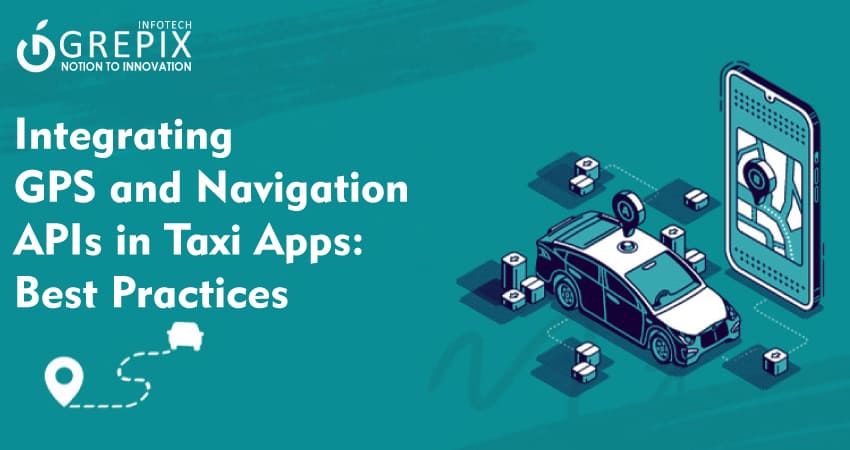Integrating GPS and Navigation APIs in Taxi Apps: Best Practices
In the age of on-demand services, taxi apps have transformed urban mobility by seamlessly connecting passengers and drivers. At the heart of every successful taxi applies the integration of GPS and navigation APIs, providing real-time location data and route optimization that makes such services convenient and reliable. Understanding and implementing best practices for integrating these APIs is essential for developing a functional, secure, scalable taxi app.
This blog will explore best practices for integrating GPS and navigation APIs into taxi apps, addressing the needs of both developers and business owners looking to enhance their application’s performance, user experience, and data security.
GPS and navigation API integration are essential for building efficient, user-friendly taxi apps that provide seamless, real-time connectivity between passengers and drivers. Best practices, such as accurate location tracking, route optimization, and strong data security, are critical in ensuring functionality, scalability, and user trust. Grepix Infotech specializes in creating customized, high-quality taxi app solutions that incorporate these best practices. Our experienced team focuses on delivering robust performance, secure data handling, and intuitive design, helping businesses meet the demands of modern on-demand services. With Grepix’s expertise, your app can deliver a reliable, next-generation urban mobility experience.
1Understanding GPS and Navigation APIs
Key Functions of GPS and Navigation APIs
- Real-time Location Tracking: Essential for displaying accurate driver and passenger locations.
- Route Optimization and ETA Calculations: Helps in finding the quickest routes and estimating arrival times.
- Geocoding and Reverse Geocoding: Converts geographic coordinates into human-readable addresses and vice versa.
- Geofencing: Specifies boundaries that, when crossed, cause alerts to sound; this is helpful for tracking and zone restrictions.
Types of GPS and Navigation APIs
- Map Display APIs: APIs like Google Maps, Mapbox, or OpenStreetMap provide visual mapping tools for in-app use.
- Navigation APIs: Help calculate optimal routes, considering real-time data such as traffic congestion.
- Location Services APIs: Provide real-time GPS coordinates and geolocation information.
- Geocoding APIs: Convert addresses to geographic coordinates, simplifying finding locations.
2 Choosing the Right GPS and Navigation API
Accuracy and Reliability
- Google Maps API: Known for high accuracy, frequent updates, and reliable traffic data.
- Mapbox API: Highly customizable, often used for custom-designed maps.
- Here API: Offers reliable global coverage, ideal for large-scale deployments.
- OpenStreetMap (OSM): Community-driven, free to use, but may lack accuracy in certain regions.
Cost Efficiency
- Usage-based Pricing Models: Consider how many API requests are likely during peak and off-peak hours.
- Free Tiers and Alternatives: Evaluate whether OpenStreetMap, with its free model, could meet your needs.
Customization Options
- Consider whether the API allows for branded or customized map views, integration of traffic data layers, and control over visual elements like markers and routes.
Data Privacy Compliance
- Ensure the chosen API complies with privacy laws like GDPR, CCPA, and other location-based data protection standards, especially if operating in multiple regions.
3 Integrating GPS and Navigation APIs in Taxi Apps
Setting Up Your Environment
- API Keys: Obtain API keys and restrict usage to prevent unauthorized access.
- Development Environment: Choose a platform like iOS or Android SDKs, which come with native tools to manage GPS.
- Access Permissions: Use appropriate methods to request location permissions from users to comply with platform requirements.
Route Optimization and ETA Calculation
- Use dynamic routing capabilities within navigation APIs to adjust routes based on real-time traffic, road closures, or accidents.
- Caching and Predictive Analytics: Pre-load frequently used locations and integrate predictive analytics to reduce the number of API calls, improving speed and reducing costs.
- Multiroute Calculation: For ridesharing and carpool services, integrate APIs that can handle complex, multi-stop routes.
Geofencing and Alerts
- Use geofencing features to monitor when a driver is close to a pickup or drop-off location. Implement automatic alerts for both drivers and passengers, triggered by geofence boundaries.
- This can be managed by setting radius boundaries around high-traffic areas, enabling quicker pickups.
Error Handling and Redundancy
- Fallback Mechanisms: Implement backup solutions, such as secondary APIs, in case the primary service goes down.
- Error Logs and Alerts: Use automated error tracking and real-time alerts to notify developers if location data becomes inconsistent or unresponsive.
4 Enhancing User Experience with Navigation APIs
Real-Time Updates and Notifications
- Transparent Communication: Share ETA updates, route adjustments, and delays through in-app notifications or SMS, keeping users informed and improving satisfaction.
- Route Visualization: Use a clear visual representation of the route on the app to reassure passengers and provide clear navigation paths for drivers.
Intuitive User Interface (UI)
- Interactive Map Elements: Allow users to interact with the map by zooming in and out, setting preferred pickup points, or marking locations directly on the map.
- Driver and Passenger Views: Create distinct views tailored to drivers (emphasizing routes, next turns, and ETAs) and passengers (highlighting pick-up points and real-time location updates).
Offline Functionality
- Implement caching techniques to enable offline maps and route guidance, especially for areas with poor network coverage.
- Provide fallback options for drivers to navigate to a saved route if GPS temporarily loses connectivity.
5 Security and Privacy Considerations
Securing API Keys and Access
- Store API keys securely using encryption techniques, ensuring they are not directly embedded in the application code.
- Limit API key usage to specific domains, regions, or IP addresses to prevent unauthorized access and abuse.
Data Encryption and Storage
- Encrypt GPS data in transit and at rest to protect sensitive location data.
- Adhere to local and international data privacy standards, ensuring users’ location data is not stored longer than necessary.
Location Permissions and User Consent
- Only request essential location permissions from users and provide transparent explanations regarding data usage.
- Ensure users have the option to revoke permissions at any time, respecting their privacy preferences.
Also Read: "Taxi App Monetization Strategies: From Ride Fares to Premium Subscriptions"
6Optimizing Performance and Minimizing Latency
Managing Data Loads
- Batch Processing: Use batch processing, which processes several location data requests at once, in place of making individual API calls.
- Rate Limiting: Set appropriate rate limits to prevent API overload during peak times and reduce the risk of service outages.
Reducing Battery Consumption
- Adaptive Polling Intervals: Adjust GPS data polling intervals based on movement speed and app usage patterns.
- Low Power Mode: Offer a low-power option that users can activate to extend battery life, which might reduce the frequency of location updates but conserve device resources.
Load Balancing and Scalability
- As your user base grows, ensure that your app can handle a large number of simultaneous API requests through server load balancing and cloud-based infrastructure.
- Load testing should be part of the regular development cycle to confirm that your infrastructure supports peak loads and high usage scenarios.
7 Testing and Continuous Improvement
Comprehensive Testing
- Simulated Environments: Use GPS simulators to test various scenarios, including poor network conditions, crowded city traffic, or rural areas.
- A/B Testing: Try different route calculation algorithms or UI elements to measure the effect on user satisfaction and app performance.
- User Feedback: Collect user feedback on route accuracy, app responsiveness, and navigation clarity, then iterate on the app design.
Regular Updates
- Keep up with the most recent API versions; these frequently include enhancements to battery efficiency, traffic prediction, and route optimization.
- Periodic app updates can also address potential bugs, security vulnerabilities, or changes in privacy compliance requirements.
8Case Studies and Success Stories
Uber’s Approach to Navigation Integration
- Uber initially used Google Maps for route mapping but transitioned to proprietary mapping technologies to control costs and improve service scalability.
- Its in-house routing algorithms optimize the app’s battery efficiency while reducing latency and maximizing route accuracy.
Lyft’s Focus on User Experience
- Lyft integrates detailed route visuals for passengers, allowing them to track progress and view ETAs with real-time adjustments.
- By prioritizing transparency, Lyft enhances user trust and satisfaction, which are crucial for service-based applications.
Conclusion
In the rapidly evolving world of on-demand app services, GPS and navigation API integration is indispensable for creating a high-quality taxi app that meets the expectations of today’s users. From accurate location tracking and efficient route optimization to user-friendly interfaces and robust security measures, the right API integration strategy enhances both operational efficiency and user experience. Implementing these best practices is critical to building a scalable, secure, responsive app.
At Grepix Infotech, we specialize in developing tailored solutions for taxi apps, ensuring seamless GPS and navigation API integration aligned with industry best practices. Our team of experienced developers prioritizes performance, data security, and intuitive design, helping your app deliver a reliable, high-quality experience to drivers and passengers alike. With our expertise, you can confidently offer a next-generation mobility solution that keeps pace with modern demands while maintaining the highest standards in technology and user satisfaction.
Looking out to start your own venture like Uber? Try out our HireMe Taxi Uber Clone, the easiest way to kick-start your taxi business.







